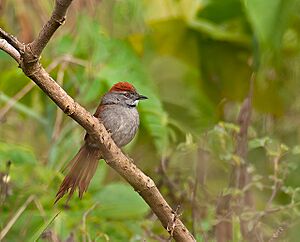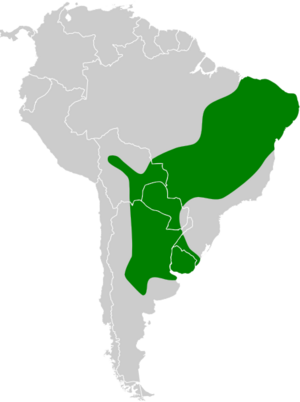Sooty-fronted spinetail facts for kids
Quick facts for kids Sooty-fronted spinetail |
|
|---|---|
 |
|
| At Piraju, São Paulo State, Brazil | |
| Conservation status | |
| Scientific classification | |
| Genus: |
Synallaxis
|
| Species: |
frontalis
|
 |
|
The sooty-fronted spinetail (Synallaxis frontalis) is a small bird. It belongs to the ovenbird family, called Furnariidae. You can find this bird in parts of South America. It lives in Argentina, Bolivia, Brazil, Paraguay, and Uruguay.
Contents
About the Sooty-fronted Spinetail
This bird is about 14 to 16 centimeters (5.5 to 6.3 inches) long. It weighs between 11 and 17 grams (0.4 to 0.6 ounces). Both male and female sooty-fronted spinetails look the same.
Their face is brownish-gray with a thin brown line through the eye. The front part of their head is dark gray-brown. The back of their head and neck are a dark reddish-brown color. Their back and rump are brown with a reddish tint.
Their wings have dark reddish-brown feathers. The tail is also dark reddish-brown. It gets narrower at the end, and the feathers have slightly pointed tips.
The bird's chin is whitish, and its throat is grayer. Below the throat, there's a blackish crescent shape with light spots. Their chest is grayish-brown, and their belly is lighter. The sides and under the tail are browner.
Their eye color can be different shades. The upper part of their beak is dark gray or blackish. The lower part is gray or light gray. Their legs and feet are olive-gray or greenish-gray. Young birds have a brownish-gray head. Their underside is a yellowish-brown color.
Where They Live and What They Like
The sooty-fronted spinetail lives in many places across South America. You can find them from northeastern Brazil all the way down to northern Argentina. They also live in eastern Bolivia, most of Paraguay, and almost all of Uruguay.
These birds like different kinds of open areas. They live near forests, especially at the edges. They also like thorny bushes, woodlands, and grassy savannas.
Bird Behavior
How They Move Around
Most sooty-fronted spinetails stay in the same area all year. They do not usually migrate. However, some birds in the very southern parts of their range might move north a little after breeding season.
What They Eat
We do not know everything about what the sooty-fronted spinetail eats. But we do know they eat beetles. They usually look for food in pairs. They pick insects off leaves and small branches. Sometimes, they also find food on the ground. They usually stay low, about 2 meters (6.5 feet) or less from the ground.
Reproduction and Nests
Sooty-fronted spinetails lay eggs in the spring and summer in the southern hemisphere. They are thought to stay with one partner. Their nest is like a ball made of thorny twigs. It has a tube-like entrance on the side. Inside, the nest is soft, lined with leaves, moss, and feathers.
They usually build their nests in thorny bushes. The nests are often about 2.5 meters (8 feet) off the ground. Sometimes, they can be as high as 4 meters (13 feet). A female bird usually lays three to four eggs. The eggs hatch after 15 to 16 days. We do not know how long it takes for the young birds to leave the nest. We also do not know much about how the parents care for their chicks.
Bird Calls and Songs
The song of the sooty-fronted spinetail sounds different to different people. Some describe it as "ka-kwee-éék" or "pi-whéé." Others hear a "du-Twee" or "teeoopooee." They often sing for a long time. They also make other sounds, like a "sew-kli" or a nasal "hoint."
Bird Status
The IUCN (International Union for Conservation of Nature) says the sooty-fronted spinetail is a species of "Least Concern." This means they are not in danger of disappearing. They live in a very large area. We do not know exactly how many there are, but their numbers seem to be growing.
There are no big threats to these birds right now. They are common in many places. They even live in some protected areas. They have also started to live in areas where forests have been cut down.


